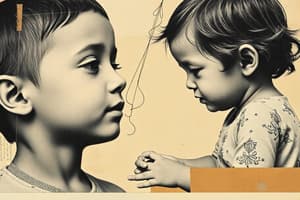Podcast
Questions and Answers
50 % ______, suggesting mothers work more.
50 % ______, suggesting mothers work more.
B
36 % ______ suggests mothers work more.
36 % ______ suggests mothers work more.
A
External ______, refers to the generalizability of the findings.
External ______, refers to the generalizability of the findings.
validity
Most observations occur in ______ environments.
Most observations occur in ______ environments.
A neutral ______ results in no response from the caregiver.
A neutral ______ results in no response from the caregiver.
Evaluation helps predict ______ in psychological studies.
Evaluation helps predict ______ in psychological studies.
Cross-cultural research aims to ensure the same ______ among researchers.
Cross-cultural research aims to ensure the same ______ among researchers.
Unconditioned response is often related to ______ pleasures.
Unconditioned response is often related to ______ pleasures.
The role of the ______ in caregiver-infant interaction is significant.
The role of the ______ in caregiver-infant interaction is significant.
Bowlby's theory emphasizes the ______ emotional bond in attachment.
Bowlby's theory emphasizes the ______ emotional bond in attachment.
Bowlby's monotropic theory rejected the ______ learning approach.
Bowlby's monotropic theory rejected the ______ learning approach.
Ainsworth's work included the ______ situation experiment.
Ainsworth's work included the ______ situation experiment.
Both mother and father must ______ to create a strong attachment.
Both mother and father must ______ to create a strong attachment.
According to Bowlby, attachment is seen as an ______ process.
According to Bowlby, attachment is seen as an ______ process.
Fathers are less likely to be the ______ responders in emotional interactions.
Fathers are less likely to be the ______ responders in emotional interactions.
Attachment theories focus on the emotional ______ between infants and caregivers.
Attachment theories focus on the emotional ______ between infants and caregivers.
The study assessed the effects of material __________ on children.
The study assessed the effects of material __________ on children.
The research involved 165 Romanian children adopted by families in the __________.
The research involved 165 Romanian children adopted by families in the __________.
The researchers compared the adopted children to a control group of 52 children adopted from __________.
The researchers compared the adopted children to a control group of 52 children adopted from __________.
Half of the adopted children showed delayed __________ development.
Half of the adopted children showed delayed __________ development.
The majority of the adopted children were __________.
The majority of the adopted children were __________.
The mean IQ of children adopted before the age of two years was __________.
The mean IQ of children adopted before the age of two years was __________.
Children who experienced _________ often face challenges in forming attachments.
Children who experienced _________ often face challenges in forming attachments.
The study highlighted both physical and __________ development in the adopted children.
The study highlighted both physical and __________ development in the adopted children.
Hunger is considered a primary ______ that drives behavior.
Hunger is considered a primary ______ that drives behavior.
Imprinting is an innate ______ observed in some species.
Imprinting is an innate ______ observed in some species.
According to Sears et al. (1957), a caregiver provides ______ to their child.
According to Sears et al. (1957), a caregiver provides ______ to their child.
Insecure attachment can result in difficulty in forming ______ in childhood.
Insecure attachment can result in difficulty in forming ______ in childhood.
Peacocks have been known to ______ on various objects during their development.
Peacocks have been known to ______ on various objects during their development.
Food is a primary ______ of hunger that influences behavior.
Food is a primary ______ of hunger that influences behavior.
The impact of childhood relationships can carry over into ______.
The impact of childhood relationships can carry over into ______.
Social workers often evaluate the ______ of relationships among different age groups.
Social workers often evaluate the ______ of relationships among different age groups.
The theory of ______ involves observing key attachments.
The theory of ______ involves observing key attachments.
Schaffer & Emerson conducted their research in ______.
Schaffer & Emerson conducted their research in ______.
The ______ observation method is used to measure attachment security.
The ______ observation method is used to measure attachment security.
When a parent smiles, a child typically ______ back.
When a parent smiles, a child typically ______ back.
By 18 months, approximately ______% of infants have formed attachments.
By 18 months, approximately ______% of infants have formed attachments.
The phrase 'proximity seeking' refers to the tendency to ______ close to attachment figures.
The phrase 'proximity seeking' refers to the tendency to ______ close to attachment figures.
Distinctive roles for ______ have been highlighted in attachment research.
Distinctive roles for ______ have been highlighted in attachment research.
Stranger ______ and separation anxiety are important indicators of attachment.
Stranger ______ and separation anxiety are important indicators of attachment.
Attachment provides a secure ______ for exploration.
Attachment provides a secure ______ for exploration.
Parents can learn cues from children to enhance ______.
Parents can learn cues from children to enhance ______.
The emotional bonds formed through attachment are crucial for ______ development.
The emotional bonds formed through attachment are crucial for ______ development.
Research indicates that attachment can lead to different ______ roles.
Research indicates that attachment can lead to different ______ roles.
Mothers often take on a primary attachment ______.
Mothers often take on a primary attachment ______.
The ______ camera is used in attachment studies to observe behaviors.
The ______ camera is used in attachment studies to observe behaviors.
Attachment theory emphasizes the importance of the caregiver for a child's ______.
Attachment theory emphasizes the importance of the caregiver for a child's ______.
The concept that a theory may work in one cultural context but not in another is known as cultural ______.
The concept that a theory may work in one cultural context but not in another is known as cultural ______.
The process of learning from the consequences of behavior is called ______ conditioning.
The process of learning from the consequences of behavior is called ______ conditioning.
In Germany, there is often a perception that mothers may lack ______ towards their children.
In Germany, there is often a perception that mothers may lack ______ towards their children.
The likelihood of repeating behavior increases with pleasant ______.
The likelihood of repeating behavior increases with pleasant ______.
Unpleasant consequences are likely to lead to less frequent ______.
Unpleasant consequences are likely to lead to less frequent ______.
The influence of early attachment on later ______ is significant in developmental psychology.
The influence of early attachment on later ______ is significant in developmental psychology.
Imprinting is a form of learning observed in some species, demonstrated by ______ in baby birds.
Imprinting is a form of learning observed in some species, demonstrated by ______ in baby birds.
According to Bowbly, the model of attachment influences how children respond when they are ______.
According to Bowbly, the model of attachment influences how children respond when they are ______.
Bowbly's research emphasized the importance of early attachment experiences during ______ development.
Bowbly's research emphasized the importance of early attachment experiences during ______ development.
Baby cries can lead to feeding, demonstrating the concept of ______ response.
Baby cries can lead to feeding, demonstrating the concept of ______ response.
In opreant conditioning, a behavior is more likely to repeat if it results in a ______ outcome.
In opreant conditioning, a behavior is more likely to repeat if it results in a ______ outcome.
In the study of animal behavior, the consequences of ______ are important for understanding learning.
In the study of animal behavior, the consequences of ______ are important for understanding learning.
The lack of affection in parenting styles may be perceived differently across ______.
The lack of affection in parenting styles may be perceived differently across ______.
The imprinting process involves young animals forming attachments to the first ______ they encounter.
The imprinting process involves young animals forming attachments to the first ______ they encounter.
The theory of attachment was proposed by ______, who studied the bonds between caregivers and children.
The theory of attachment was proposed by ______, who studied the bonds between caregivers and children.
Flashcards
External Validity
External Validity
The extent to which the results of a study can be generalized to other settings, populations, and times.
Neutral Stimulus
Neutral Stimulus
A stimulus that does not initially elicit a response.
Unconditioned Response
Unconditioned Response
A response that is naturally elicited by an unconditioned stimulus.
Unconditioned Stimulus
Unconditioned Stimulus
Signup and view all the flashcards
Conditioned Response
Conditioned Response
Signup and view all the flashcards
Conditioned Stimulus
Conditioned Stimulus
Signup and view all the flashcards
Caregiver-Infant Attachment
Caregiver-Infant Attachment
Signup and view all the flashcards
Bowlby's Monotropic Theory
Bowlby's Monotropic Theory
Signup and view all the flashcards
Reciprocal Attachment
Reciprocal Attachment
Signup and view all the flashcards
Attachment to Father
Attachment to Father
Signup and view all the flashcards
Ainsworth's Strange Situation
Ainsworth's Strange Situation
Signup and view all the flashcards
Rejection of Learning Theories
Rejection of Learning Theories
Signup and view all the flashcards
Evolutionary Basis of Attachment
Evolutionary Basis of Attachment
Signup and view all the flashcards
Types of Attachment
Types of Attachment
Signup and view all the flashcards
Attachment
Attachment
Signup and view all the flashcards
Schaffer & Emerson's Study (1964)
Schaffer & Emerson's Study (1964)
Signup and view all the flashcards
Separation Anxiety
Separation Anxiety
Signup and view all the flashcards
Stranger Anxiety
Stranger Anxiety
Signup and view all the flashcards
Primary Caregiver
Primary Caregiver
Signup and view all the flashcards
Learning Cues
Learning Cues
Signup and view all the flashcards
Father's Role in Attachment
Father's Role in Attachment
Signup and view all the flashcards
Brazelton's Theory
Brazelton's Theory
Signup and view all the flashcards
Secure Base
Secure Base
Signup and view all the flashcards
Secure Attachment
Secure Attachment
Signup and view all the flashcards
Avoidant Attachment
Avoidant Attachment
Signup and view all the flashcards
Ambivalent Attachment
Ambivalent Attachment
Signup and view all the flashcards
Disorganized Attachment
Disorganized Attachment
Signup and view all the flashcards
Attachment Security
Attachment Security
Signup and view all the flashcards
Pre-attachment
Pre-attachment
Signup and view all the flashcards
Attachment-in-the-making
Attachment-in-the-making
Signup and view all the flashcards
Clear-cut attachment
Clear-cut attachment
Signup and view all the flashcards
Anxious-ambivalent attachment
Anxious-ambivalent attachment
Signup and view all the flashcards
Rutter et al. (2011) Romanian Orphan Study
Rutter et al. (2011) Romanian Orphan Study
Signup and view all the flashcards
Material Deprivation
Material Deprivation
Signup and view all the flashcards
Procedure of the Romanian Orphan Study
Procedure of the Romanian Orphan Study
Signup and view all the flashcards
Development Assessed in the Romanian Orphan Study
Development Assessed in the Romanian Orphan Study
Signup and view all the flashcards
Findings of the Romanian Orphan Study
Findings of the Romanian Orphan Study
Signup and view all the flashcards
IQ Scores of Adopted Romanians
IQ Scores of Adopted Romanians
Signup and view all the flashcards
Significance of the Romanian Orphan Study
Significance of the Romanian Orphan Study
Signup and view all the flashcards
Brain Plasticity and the Romanian Orphan Study
Brain Plasticity and the Romanian Orphan Study
Signup and view all the flashcards
Etic Assumption
Etic Assumption
Signup and view all the flashcards
Operant Conditioning
Operant Conditioning
Signup and view all the flashcards
Reinforcement
Reinforcement
Signup and view all the flashcards
Punishment
Punishment
Signup and view all the flashcards
Influence of Early Attachment
Influence of Early Attachment
Signup and view all the flashcards
Internal Working Model
Internal Working Model
Signup and view all the flashcards
Imprinting
Imprinting
Signup and view all the flashcards
Habituation
Habituation
Signup and view all the flashcards
Lorenz's Imprinting Study
Lorenz's Imprinting Study
Signup and view all the flashcards
Bowlby's Attachment Theory
Bowlby's Attachment Theory
Signup and view all the flashcards
Attachment Deprivation
Attachment Deprivation
Signup and view all the flashcards
Harlow's Monkey Studies
Harlow's Monkey Studies
Signup and view all the flashcards
Empathy
Empathy
Signup and view all the flashcards
Emotional Regulation
Emotional Regulation
Signup and view all the flashcards
Identity Formation
Identity Formation
Signup and view all the flashcards
Study Notes
Caregiver-Infant Interaction
- Attachment is a reciprocal emotional bond.
- Reciprocal bonding involves both caregiver and child.
- Fathers can also form attachments.
- Fathers are less likely to be the primary attachment figure.
- Interaction synchrony is crucial; actions become synchronized.
- Schaffer and Emerson (1964) research found that attachment often forms by 18 months.
- The father plays a distinctive role, though differing from the mother's.
- Brazelton et al. (1975) demonstrated interaction synchrony.
- Sensitive responsiveness to a baby's needs correlates with stronger attachments.
Stages of Attachment
- Schaffer and Emerson (1964) identified stages of attachment.
- Stages involve a progression from asocial to selective attachment.
- Asocial (0-6 weeks): Respond to all people equally.
- Indiscriminate (6-7 months): Preference for familiar people.
- Specific (7 months onwards): Attachment to one caregiver.
- Multiple (10-11 months+): Attachments to multiple figures.
- Observations are often in natural environments.
- External validity is high, but internal validity is low.
Animal Studies
- Lorenz (1952): Imprinting in geese.
- Incubator geese imprinted on Lorenz; natural hatched geese followed their mother.
- Imprinting is a rapid learning process, critical period for forming an attachment to a figure.
Bowlby's Theory
- Bowlby's theory is an evolutionary one; attachment is innate.
- Monotropy: Importance of one primary attachment figure.
- Law of continuity: Consistent care leads to better quality attachments.
- Law of accumulated separation: Effect of separations adds up.
- Social releases: Cute behaviors to encourage adult interaction.
- Internal working model: Mental representation of relationships.
- Attachment behaviors give survival advantages.
Learning Theory
- Classical conditioning; association of two stimuli.
- Operant conditioning: Learning from consequences.
Types of Attachment
- Ainsworth's Strange Situation: Observations of attachment types.
- Secure attachment (B): Explores when caregiver is present and seeks comfort when not.
- Insecure-avoidant (A): Explore freely without seeking proximity to caregiver.
- Insecure-resistant (C): Explore less, seek greater proximity and resist comfort from caregiver.
- Observations of attachment are often reliable.
- Attachment types can vary across cultures.
Cultural Variations
- Van Ijzendoorn and Kroonenberg (1988): Meta-analysis of attachment types worldwide.
- Secure attachment most common globally.
- Cultural variations in attachment are influenced by the cultural context.
Harlow's Research
- Harlow (1958) studied attachment in monkeys with surrogate mothers.
- Comfort is more important than food in forming attachments.
- Monkeys separated from mothers displayed negative behaviors.
Influence on Later Relationships
- Early attachment types predict later relationships.
- Secure attachment is linked to positive adult relationships.
- Insecure attachments may predict difficulties in relationships.
- Retrospective data analysis challenges validity.
Maternal Deprivation
- Maternal deprivation: Absence of a mother.
- Separation vs. deprivation: Brief separation is less harmful than prolonged deprivation.
- Critical periods for development; potential psychological damage if deprived of emotional care during critical periods.
- Effects of maternal deprivation on intellectual and emotional development.
- The 44 thieves study (Bowlby): Investigated the link between maternal deprivation and delinquency.
Romanian Orphan Studies
- Rutter et al (2011): Longitudinal study of Romanian orphans adopted into UK.
- Adoption before 6 months led to catch-up in development.
- Disinhibited attachment: Attachment to all people.
- Zeanah et al (2005): Assessed attachment in Romanian children institutionalised.
- Disrupted attachment: Difficulties forming relationships with caregivers.
- Important Real-world applications in improving services for children in orphanages.
Studying That Suits You
Use AI to generate personalized quizzes and flashcards to suit your learning preferences.
Related Documents
Description
This quiz explores key concepts and theories related to attachment in psychology, focusing on Bowlby and Ainsworth's contributions. It includes important terms, methods, and implications of caregiver-infant interactions. Test your understanding of attachment processes and external validity in psychological research.





